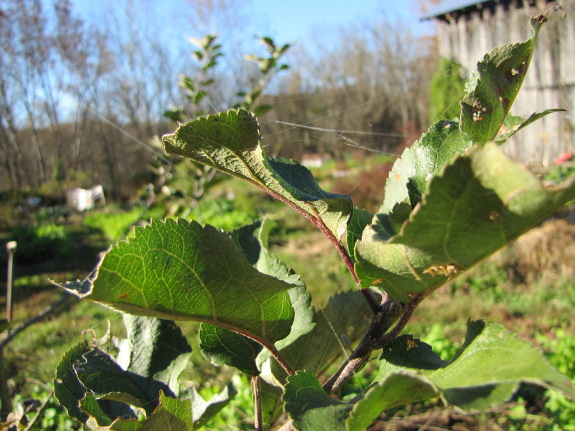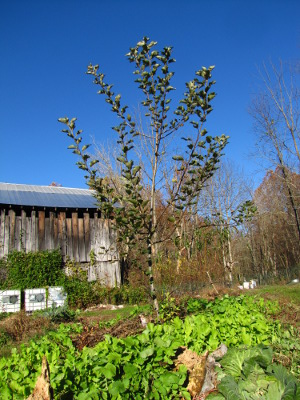
MM111: Good apples start underground

Like most amateur
fruit-growers, I've had a tendency to ignore the rootstock when
selecting new trees. Reading The
Holistic Orchard and
The
Grafter's Handbook,
though, helped me realize that rootstocks are responsible for a lot
more than the size of the tree, so I dropped an email to my
favorite orchard
(the source of a lot of my apples) to see what rootstock I currently
have in my garden.
MM111 is one of the
older apple rootstocks, and it's still around for a reason --- it's
clearly a workhorse. The roots do just what they should,
anchoring the apple trees firmly and helping them survive in poorly
drained, heavy clay soil (like mine). While some other fruit
trees have perished in our garden, my apples on MM111 keep plugging
along.
 On the negative side, trees
grafted onto MM111 seem to be inclined toward burr knotting, and (as
with all dwarfing rootstocks) the trees don't live quite as long as
seedlings --- 40 years instead of 75, in this case. If you're
concerned about the disadvantages of MM111 (or of any other rootstock),
you can plant the tree deep enough to bury the graft union and the
scionwood will root, creating what's essentially a seedling tree (which
may have its own disadvantages).
On the negative side, trees
grafted onto MM111 seem to be inclined toward burr knotting, and (as
with all dwarfing rootstocks) the trees don't live quite as long as
seedlings --- 40 years instead of 75, in this case. If you're
concerned about the disadvantages of MM111 (or of any other rootstock),
you can plant the tree deep enough to bury the graft union and the
scionwood will root, creating what's essentially a seedling tree (which
may have its own disadvantages).
Of course, size does
matter, not only because you might not fit a full-size apple tree into
your homestead, but also because smaller trees bear much faster (4 to 6
years in this case compared to 8 to 12 years for a seedling
tree). MM111 produces a tree that's 70% to 85% the size of a
seedling (aka standard) apple tree, with the lower figure referring to
less vigorous, spur apples and the larger size referring to more
vigorous varieties. (This site
gives information on the vigor of many common apple varieties.)
That means your tree is likely to get 14 to 20 feet tall (depending,
again, on vigor of the scionwood variety), and trees should be spaced
that distance apart.
Yellow Transparent is
listed as very vigorous, but my other varieties are supposed to have
medium vigor, so I think I've actually given my apple trees more room
than they need (25 feet between each one). That's good news since
it gives me space in between for extra forest garden experimentation
--- more on that in a later post.
Want more in-depth information? Browse through our books.
Or explore more posts by date or by subject.
About us: Anna Hess and Mark Hamilton spent over a decade living self-sufficiently in the mountains of Virginia before moving north to start over from scratch in the foothills of Ohio. They've experimented with permaculture, no-till gardening, trailersteading, home-based microbusinesses and much more, writing about their adventures in both blogs and books.
Want to be notified when new comments are posted on this page? Click on the RSS button after you add a comment to subscribe to the comment feed, or simply check the box beside "email replies to me" while writing your comment.

Your article helped me diagnose that our apple tree has burr knot.
I did notice this apple tree (from an unreputable source) was bud grafted with multiple varieties so the lowest 18" of the trunk was all root stock, and all our other apple trees have the graft union very low.
I'd wonder if this is to reduce the chance of having Burr Knot?